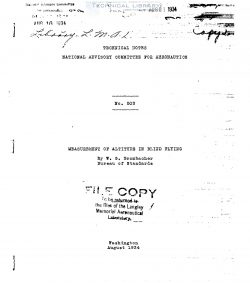naca-tn-503
- Version
- 135 Downloads
- 1.89 MB File Size
- 1 File Count
- November 25, 2016 Create Date
- November 25, 2016 Last Updated
National Advisory Committee for Aeronautics, Technical Notes - Measurement of Altitude in Blind Flying

Instruments for measuring altitude and rate of change
of altitude in blind flying and landing of aircraft and
their performance are discussed. Of those indicating the
altitude above ground level, the sonic altimeter is the
most promising. Its present bulk; intermittent operation.
and more or less unsatisfactory means of indication are
serious drawbacks to its use.
The sensitive type aneroid altimeter is now quite
generally used. Dividing the errors incident to its use
into thOse due to the instrument and those inherent in the
barometric method of measuring altitude, it is shown that
the instrumental errors, except the error arising from
changes in instrument temperature, do not ordinarily ox—
ceed 0.75 percent of its range (20,000 feet) when using
the instrument to fly at a definite pressure level.’ These
can be reduced to an.uncertainty of 40 feet_in landing at
an airport if corrections are applied.
Of the other errors, that due to variation in air
temperature from the temperature of the standard atmos~
phere gives rise to errors as high as 10 percent} but ig—
noring this error doesfnot usually cause a serious loss in
safety since at any particular time it is very nearly a
constant percentage of the altit ud.e. The error introduced
by change in the barometric pressure at the ground level
with time and place may be as mvch as $300 feet in summer
and $1,000 feet in winter, and can be corrected for only
at the time of landing by obtaining data on the air preeé
sure at the ground level from an airport. The instiunent
can be used in clearing obstacles only when their eleva—
tion and location are known. '
The errors in flying at a pressure level and in land—
ing are discussed in detail.
When flying under conditions of low or zero visibil-
ity, an indication of the altitude of the airplane is es—
sential to safe and preper navigation.
| File | Action |
|---|---|
| naca-tn-503 Measurement of Altitude in Blind Flying.pdf | Download |

Comment On This Post